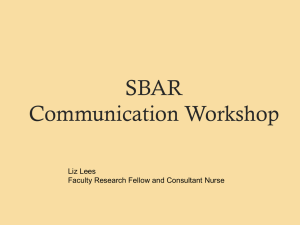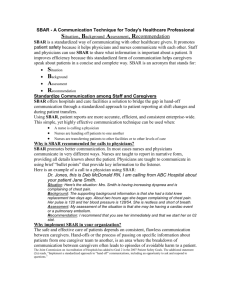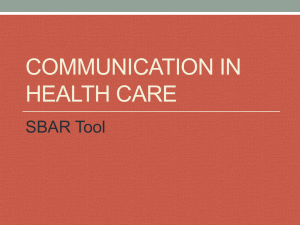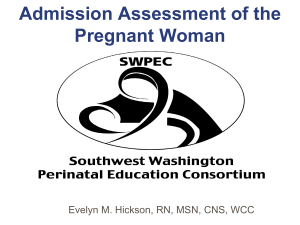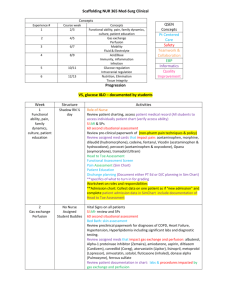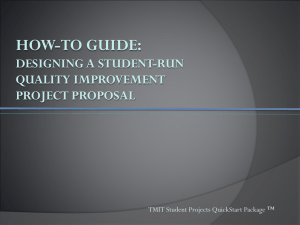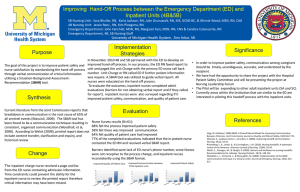SBAR - 1000 Lives Plus
advertisement
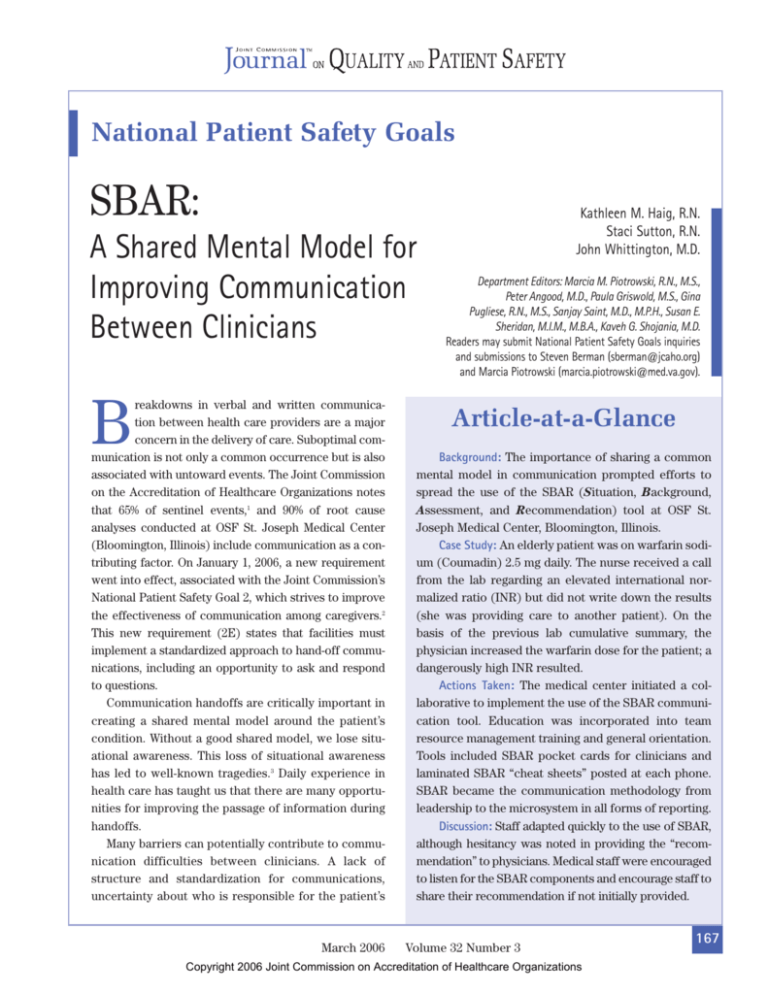
National Patient Safety Goals SBAR: A Shared Mental Model for Improving Communication Between Clinicians reakdowns in verbal and written communication between health care providers are a major concern in the delivery of care. Suboptimal communication is not only a common occurrence but is also associated with untoward events. The Joint Commission on the Accreditation of Healthcare Organizations notes that 65% of sentinel events,1 and 90% of root cause analyses conducted at OSF St. Joseph Medical Center (Bloomington, Illinois) include communication as a contributing factor. On January 1, 2006, a new requirement went into effect, associated with the Joint Commission’s National Patient Safety Goal 2, which strives to improve the effectiveness of communication among caregivers.2 This new requirement (2E) states that facilities must implement a standardized approach to hand-off communications, including an opportunity to ask and respond to questions. Communication handoffs are critically important in creating a shared mental model around the patient’s condition. Without a good shared model, we lose situational awareness. This loss of situational awareness has led to well-known tragedies.3 Daily experience in health care has taught us that there are many opportunities for improving the passage of information during handoffs. Many barriers can potentially contribute to communication difficulties between clinicians. A lack of structure and standardization for communications, uncertainty about who is responsible for the patient’s B March 2006 Kathleen M. Haig, R.N. Staci Sutton, R.N. John Whittington, M.D. Department Editors: Marcia M. Piotrowski, R.N., M.S., Peter Angood, M.D., Paula Griswold, M.S., Gina Pugliese, R.N., M.S., Sanjay Saint, M.D., M.P.H., Susan E. Sheridan, M.I.M., M.B.A., Kaveh G. Shojania, M.D. Readers may submit National Patient Safety Goals inquiries and submissions to Steven Berman (sberman@jcaho.org) and Marcia Piotrowski (marcia.piotrowski@med.va.gov). Article-at-a-Glance Background: The importance of sharing a common mental model in communication prompted efforts to spread the use of the SBAR (Situation, Background, Assessment, and Recommendation) tool at OSF St. Joseph Medical Center, Bloomington, Illinois. Case Study: An elderly patient was on warfarin sodium (Coumadin) 2.5 mg daily. The nurse received a call from the lab regarding an elevated international normalized ratio (INR) but did not write down the results (she was providing care to another patient). On the basis of the previous lab cumulative summary, the physician increased the warfarin dose for the patient; a dangerously high INR resulted. Actions Taken: The medical center initiated a collaborative to implement the use of the SBAR communication tool. Education was incorporated into team resource management training and general orientation. Tools included SBAR pocket cards for clinicians and laminated SBAR “cheat sheets” posted at each phone. SBAR became the communication methodology from leadership to the microsystem in all forms of reporting. Discussion: Staff adapted quickly to the use of SBAR, although hesitancy was noted in providing the “recommendation” to physicians. Medical staff were encouraged to listen for the SBAR components and encourage staff to share their recommendation if not initially provided. Volume 32 Number 3 Copyright 2006 Joint Commission on Accreditation of Healthcare Organizations 167 care management (quarterback of the team), hierarchy, sex, and ethnic background may all be contributing factors.4 Differences in communication styles between nurses and physicians are also a major contributing factor.5 Because of varied training approaches, nurses tend to be very descriptive and detailed in their communications, whereas physicians tend to use brief statements summarizing salient patient information, sometimes called “bullet points” or “headlines.” Variations in communication style can cause frustration. In Fall 2002, OSF St. Joseph Medical Center recognized that some of the communication problems between clinicians could be linked to variations in communication styles. We started looking for ideas to improve communication. Michael Leonard, M.D., physician leader for patient safety at Kaiser Permanente (Denver) introduced us to a model of structured communication that would help clinicians have a shared mental model for the patient’s clinical condition. He called this structured communication SBAR—–Situation, Background, Assessment, and Recommendation.6,7 Implementing Use of SBAR at the Medical Center Investigation of near-miss occurrences and results of root cause analyses resulted in identification of a need to develop a standardized approach to hand-off communications among caregivers. Stories of actual cases demonstrated the impact of misinterpreted communication from nurse-to-nurse, nurse-to-physician, and physician-to-physician. One such story involved an elderly patient who was on warfarin sodium (Coumadin) 2.5 mg daily. The nurse received a call from the lab regarding an elevated international normalized ratio (INR) for this patient but did not write down the results, as she was in the process of providing care to another patient. Later, when she saw the physician, she asked him if he saw the patient’s INR results to which he responded, “Yes.” However, he was looking at a cumulative summary from the lab which did not include the most recent elevated INR results. On the basis of the information on the lab cumulative summary, the physician increased 168 March 2006 the warfarin sodium dose for the patient, resulting in a dangerously elevated INR. In 2003, to promote a culture of safety, OSF St. Joseph Medical Center selected SBAR as a mechanism to support open, honest communication for sharing information, asking questions, and providing suggestions. However, SBAR was not aggressively implemented at that time. The framework for spread of SBAR entailed leadership, better ideas, set-up, and the social system.8 As leadership support has been found to be key to the success in previous projects, this topic was selected in 2004 as a key project in the system strategic map for fiscal year (FY) 2005. Goals were aligned with incentives by naming the chief nurse officer (CNO) as the executive leader of the team, with a portion of her compensation being based on achieving the goal. The CNO asked staff questions regarding SBAR during her rounding and requested that requests and/or reporting of issues be forwarded using the SBAR format. In addition, the medical director was named as an executive sponsor to champion the use of SBAR among medical staff peers. The medical director not only promoted the use of SBAR among staff when reporting a patient condition to him but also encouraged his peers to listen for the use of SBAR and to encourage the staff to provide the “R” or recommendation. The patient safety officer [K.H.] was delegated as the project’s day-to-day leader. The interdisciplinary Spread Team, representing multiple nursing units, pharmacy, rehab, medical imaging, education staff, and media relations was established. It met biweekly for one hour for a period of one year (September 2004–September 2005). The team’s aims, as stated in its charter, were as follows: ■ Improve communication among clinical caregivers ■ Provide timely and accurate information through spread of the use of the SBAR communication tool ■ Extend education relative to team resource management concepts9–13 to improve the efficiency, timeliness, and effectiveness of team interventions throughout the medical center In September 2004, the spread team was assigned the task of developing “better ideas” to describe the case for use of SBAR to reduce communication deficits Volume 32 Number 3 Copyright 2006 Joint Commission on Accreditation of Healthcare Organizations as a contributing factor to potential adverse events. The first better idea was development of an “elevator speech”—a description of SBAR in a few short sentences—to explain the project’s intent. The set-up targeted the clinical caregivers, including nurses, lab personnel, medical imaging personnel, rehab personnel, dieticians, social services personnel, pharmacists, and physicians for the initial spread plan. Initial key messengers to spread the Better Ideas included team members and Nursing Practice Council members. These members were asked to select one peer who was an early adopter to create a Social System for the spread of SBAR. Technical support aided knowledge management by providing measurement and feedback to the adopter audiences. Table 1. Reporting Documents Incorporating Situation, Background, Assessment, and Recommendation (SBAR) ■ ■ ■ ■ ■ ■ ■ ■ ■ Addressing the Spread of SBAR Efforts to promote the use of SBAR began in April 2004, approximately five months before the formal team formation, through introduction of the concept in clinical educational settings. Baseline information was obtained in August 2004, during the project’s pre-implementation phase, through a “secret shoppers” survey. Ten staff members were called at random by either the corporate or the internal patient safety officer. They were asked to describe what SBAR stood for and then provide an example of how this concept is used in their daily communications. Results of the monthly survey were displayed on a run chart and shared throughout the organization for feedback. The baseline data demonstrated that, on average, staff were able to respond correctly 60% of the time. In September 2004, the team set an aim to increase the use of the SBAR communication tool to 90% by September 2005. Starting in November 2004, team resource management on the SBAR concept was conducted in multiple areas, specifically the intensive care unit/post-intensive care unit (ICU/PICU), respiratory, cardiac rehabilitation, cardiac catheterization lab, interventional radiology, medical, surgical, float/registry, pediatrics, transitional care unit, and supervision staff. This training was selected as an organizational goal to support the improvement efforts. Using the Plan, Do, Study, Act (PDSA) performance improvement methodology, efforts to incorporate SBAR March 2006 ■ Shift report hand-off tools specific to specialty nursing units (labor, postpartum, nursery) Strategic goal-reporting Emergency medical services run reports SBAR briefings for emergency department cardiac arrests and/or trauma patients Charge nurse to charge nurse briefing tool Incident reports Shift hand-off reports, including certified nursing assistants Case review descriptions Hospital forms (including administrative staff meeting minutes, the ethics committee issue form, and the inpatient and outpatient satisfaction reporting tools) A service excellence report to report patient and/or staff opportunities for improvement to managers of all hospital departments began on a general medical nursing unit in October 2004. Tests of change were conducted with tools created by the team, and revisions were made on the basis of input from the front-line staff members who piloted the tool. Tests were small, using one person for one day and gradually increasing those involved in the test until a workable tool was obtained. Once this was achieved, the SBAR trigger tool was spread to the surgical unit in January 2005 and to the critical care unit in March 2005. Finally, SBAR was spread housewide in April 2005, following meetings with managers of nonclinical areas, such as social services, rehabilitation, medical imaging, and pharmacy. Identifying and Implementing Solutions Better ideas included incorporation of SBAR into a variety of reporting documents, as listed in Table 1 (above). Multiple mechanisms were used to spread the use of SBAR, including those listed in Table 2 (page 170). The laminated poster is shown in Figure 1 (page 171), the nurse’s report to a physician in Figure 2 (page 172), and the hand-off form in Figure 3 (page 173). Volume 32 Number 3 Copyright 2006 Joint Commission on Accreditation of Healthcare Organizations 169 Table 2. Mechanisms to Spread Use of Situation, Background, Assessment, and Recommendation (SBAR) ■ ■ ■ ■ ■ ■ ■ ■ ■ ■ ■ ■ ■ ■ ■ ■ ■ Laminated posters displayed on the units Stickers placed on each phone at the nursing units Middle managers shared stories of staff’s SBAR use, and these staff members were recruited as spread agents to their peers Examples developed for nonclinical areas Staff on the obstetrics unit conducted peer observation for the use of SBAR in nurse-physician communication and shift hand-off reports Input from the patient services practice council was obtained in development of a user-friendly tool for shift hand-off reports Staff “practiced” their SBAR hand-off reports to physicians with peers before making the call Monthly games/quizzes, with rewards Good examples of SBAR were recognized by being published on Web sites, on hospital bulletin boards, in hospital publications, and so on Peer assist meetings* were held to brainstorm ideas for use of SBAR among different departments A shared drive was developed to share data and team activities The medical director asked physicians to listen for use of SBAR in communication from nursing staff and encourage nursing staff to give the “R” part of SBAR (recommendation) SBAR training and a follow-up quiz were added to all new employees’ orientation SBAR was incorporated into annual safety education for all employees SBAR was included in team resource management training Screensavers were used to promote knowledge and use of SBAR A safety hotline using SBAR was created * Dixon N.M.: Does your organization have an asking problem? Knowledge Management Review 7:18–23, May–Jun. 2004. ■ Leadership: key strategic initiative, goals, and incentives are aligned, and an executive sponsor was delegated ■ Better ideas: develop the case and describe the ideas ■ Set-up—target population: early adopters ■ Social system and communication: key messengers, communication strategies, and technical support ■ Measurement and feedback Stories were shared that demonstrated missed opportunities and the resulting impact, as well as success stories in which SBAR facilitated a shared mental model. Decision aids, standardization, redundancy of SBAR in hospital forms, and forcing functions in reporting tools led to early successes. Educational training was provided for current and new staff. Constant reminders by leadership in requiring documentation to be in the SBAR format assisted in early adoption. Spread efforts were advanced to all departments, including nonclinical areas, for use in communication and documentation. The spread team found it difficult to identify outcome measures and sought advice from behavior experts. The team then arrived at the following two outcome measures: ■ Consistent use of the medication reconciliation process. Timely and accurate communication between nurses, pharmacists, and physicians is critical to accomplish medication reconciliation. This communication must occur at multiple points during the inpatient stay, including admission, transfer between units, and discharge.14–17 Variances in medication lists can result in duplication, omission, wrong doses, and so on, potentially resulting in patient harm. Using SBAR communication techniques should result in improved use of the medication reconciliation process. ■ Number of adverse patient events. Improved communication should improve the efficiency and effectiveness of teamwork and thus result in a reduction of all types of adverse events to patients. Results Process Measure: Use of SBAR Feasibility and Implementation Issues Implementation approaches included the following strategies: 170 March 2006 St. Joseph Medical Center realized a mean of 96% use of SBAR in FY 2005 (Figure 4, page 174). Team resource management training was conducted with Volume 32 Number 3 Copyright 2006 Joint Commission on Accreditation of Healthcare Organizations Laminated Poster Figure 1. The information on the laminated poster, also reproduced on the pocket cards for clinicians, describes the Situation, Background, Assessment, and Recommendation (SBAR) steps, with an example for each. 98.3% of targeted staff, exceeding a goal of 90%. Retraining was completed with 87% of targeted staff. Abbreviated versions of team resource management training was provided to 39% of physicians and midlevel practitioners, exceeding the goal of 25%. Outcome Measures: Medication Reconciliation and Adverse Events The spread team considered medication reconciliation and adverse events as separate processes not directly dependent on SBAR. However, the team’s thinking was that better communication, reflecting SBAR use, would improve reconciliation and the incidence of adverse events. March 2006 The frequency of medication reconciliation demonstrated notable gains from October 2002–August 2004 to September 2004–December 2005—admission reconciliation improved from a mean of 72% to a mean of 88% (Figure 5, page 174), and discharge reconciliation improved from a mean of 53% to a mean of 89% (Figure 6, page 175). The rate of adverse events was measured using the Global Trigger Tool, which contains a list of multiple triggers appropriate for general care, surgical care, intensive care, emergency department, medication, laboratory and perinatal care that prompt the reviewer to look further for evidence of an adverse event.18–20 The rate of events per 1,000 patient days is measured Volume 32 Number 3 Copyright 2006 Joint Commission on Accreditation of Healthcare Organizations 171 Nurse’s Report to a Physician Figure 2. The Situation, Background, Assessment, and Recommendation (SBAR) Report to a Physician is intended for a nurse making a report to a physician. 172 March 2006 Volume 32 Number 3 Copyright 2006 Joint Commission on Accreditation of Healthcare Organizations Hand-off Form Figure 3. The hand-off form can be used by nurses at shift change. March 2006 Volume 32 Number 3 Copyright 2006 Joint Commission on Accreditation of Healthcare Organizations 173 by calculating the total number of events, dividing by the total of length of stay for all charts reviewed, and multiplying by 1000. Each month, 20 charts were chosen at random to be reviewed. The rate of events was reduced from a baseline of 89.9 per 1,000 patient days in October 2004 to 39.96 per 1,000 patient days overall in FY 2005. Adverse drug events identified through use of the Global Trigger Tool decreased from a baseline of 29.97 per 1,000 patient days to 17.64 per 1,000 patient days. Reflections SBAR Use, 2004–2005 Figure 4. Use of Situation, Background, Assessment, and Recommendation (SBAR) reached a mean of 96% in fiscal year 2005. Use of SBAR in Admission Reconciliation, 2004–2005 The power of top management’s involvement in performance improvement projects was realized. Select leaders from the top management team were not only involved in implementing SBAR but also provided human, technological, and financial resources. Flattening of the hierarchy among nursing staff and physicians led to a cooperative effort to improve communication and improved satisfaction for each of those populations. It was helpful to start with a small Figure 5. Use of Situation, Background, Assessment, and Recommendation group, which included a few key (SBAR) in medication reconciliation at admission improved from a mean of 72% to a mean of 88%. members and early adopters, and then spread the change to peers. Use of story-telling promoted the benefits of good Summary and Conclusions communication and the potential hazards of poor For OSF St. Joseph Medical Center, use of SBAR in both communication. Selecting team members from areas oral and written communication has improved patient in which SBAR plays a crucial role led to early safety by providing clear, accurate feedback of informaadoption and buy-in of the concept. The addition tion between caregivers. There are fewer incidents of of a media relations staff member and the incorporamissed information during handoffs since SBAR was tion of information technology assisted the team in implemented because concise facts are shared in an feedback. organized format. Next steps include integration of SBAR into the elecStaff members are encouraged to “recommend” tronic medical record for documentation by all clinical on the basis of their observations, and this assists caregivers. physicians with situational awareness through the 174 March 2006 Volume 32 Number 3 Copyright 2006 Joint Commission on Accreditation of Healthcare Organizations Use of SBAR in Discharge Reconciliation, 2004–2005 Figure 5. Use of Situation, Background, Assessment, and Recommendation (SBAR) in medication reconciliation at discharge improved from a mean of 53% to a mean of 89%. Kathleen M. Haig, R.N., is Director, Quality Resource Management/Risk Manager/Patient Safety Officer, and Staci Sutton, R.N., is Emergency Services Manager, OSF St. Joseph Medical Center, Bloomington, Illinois. John Whittington, M.D., is Patient Safety Officer/Director of Knowledge Management, OSF Healthcare System, Peoria, Illinois. Please address correspondence to John Whittington, john.w.whittington@osfhealthcare.org. References 1. Joint Commission on Accreditation of Healthcare Organizations: Sentinel Event Statistics-June 30, 2005. http://www.jcaho.org/accredited+organizations/sentinel+event/sentinel+event+statistics.htm (last accessed Jan. 24, 2006). 2. Joint Commission on Accreditation of Healthcare Organizations: 2006 Critical Access Hospital and Hospital National Patient Safety Goals. http://www.jcaho.org/accredited+organizations/patient+ safety/06_npsg/06_npsg_cah_hap.htm (last accessed Jan. 24, 2006). 3. Wachter R.M., Shojania K.G.: Internal Bleeding: The Truth Behind America's Terrifying Epidemic of Medical Mistakes. New York: Rugged Land, 2004. 4. Thomas E.J., Sexton J.B., Helmreich R.L.: Discrepant attitudes about teamwork among critical care nurses and physicians. Crit Care Med 31:956–959, Mar. 2003. 5. Greenfield L.J.: Doctors and nurses: A troubled partnership. Ann Surg 230:279-288, Sep. 1999. 6. Leonard M., Graham S., Bonacum D.: The human factor: The critical importance of effective teamwork and communication in providing safe care. Qual Saf Health Care 13 (suppl 1):i85–i90, Oct. 2004. 7. McFerran S.C., et al.: Perinatal patient safety project: A multicenter approach to improve performance reliability at Kaiser Permanente. J Perinat Neonatal Nurs 19:37–45, Jan.–Mar. 2005. March 2006 eyes of the bedside caregiver. Staff members feel empowered and have influence over decisions that affect work life using SBAR, thus improving job satisfaction. Currently, SBAR tools are being tested in communication handoffs between shifts, for transfers to other departments (for example, radiology, operating room), and with patients admitted from the emergency department. SBAR promotes the six aims of the Institute of Medicine in providing safe, efficient, effective, equitable, timely, and patient-centered lines of communication.21 J 8 Institute for Healthcare Improvement: Framework for Spread. http://www.ihi.org/IHI/Topics/Improvement/SpreadingChanges/Chang es/ (last accessed Jan. 24, 2006). 9. Helmreich R.L., Merritt A.C.: Culture at Work in Aviation and Medicine: National, Organizational and Professional Influences. Aldershot, U.K.: Ashgate, 2001. 10. Helmreich RL. On error management: Lessons from aviation. BMJ 320(7237):781–785, Mar. 2000. 11. Kosnik L.K.: The new paradigm of crew resource management: just what is needed to re-engage the stalled collaborative movement? Jt Comm J Qual Improv 28:235–241, May 2002. 12. Risser D.T., et al.: The potential for improved teamwork to reduce medical errors in the emergency department. The MedTeams Research Consortium. Ann Emerg Med 34:373-383, Sep. 1994. 13. Wiener E.L., Kanki B.G., Helmreich R.L.: Cockpit Resource Management. San Diego: Harcourt Brace, 1993. 14. Gleason K.M., et al.: Reconciliation of discrepancies in medication histories and admission orders of newly hospitalized patients. Am J Health Syst Pharm 61:1689–1695, Aug. 15, 2004. 15. Pronovost P., et al.: Medication reconciliation tool: A practical tool to reduce medication errors during patient transfer from an intensive care unit. Journal of Clinical Outcomes Management 11:26–33, Jan. 2004. 16. Rozich J.D., et al.: Medication safety: One organization's approach to the challenge. Journal of Clinical Outcomes Management 8:27–34, Oct. 2001. 17. Whittington J., Cohen H.: OSF healthcare's journey in patient safety. Qual Manag Health Care 13:53-59, Jan.–Mar. 2004. 18. Resar R.K., Rozich J.D., Classen D.: Methodology and rationale for the measurement of harm with trigger tools. Qual Saf Health Care 12 (suppl 2):ii39–ii45, Dec. 2003. 19. Rozich J.D., Haraden C.R., Resar R.K.: Adverse drug event trigger tool: A practical methodology for measuring medication related harm. Qual Saf Health Care 12:194–200, Jun. 2003. 20. Institute for Healthcare Improvement: Global Trigger Tool for Measuring Adverse Events (IHI Tool). http://www.ihi.org/IHI/Topics/ PatientSafety/SafetyGeneral/Tools/GlobalTriggerToolforMeasuringAE s.htm (last accessed Jan. 24, 2006). 21. Institute of Medicine: Crossing the Quality Chasm. Washington, D.C.: National Academy Press, 2001. Volume 32 Number 3 Copyright 2006 Joint Commission on Accreditation of Healthcare Organizations 175
